A Trainer With Attitude
The Diamond DA20 brings fun and enthusiasm to flight training
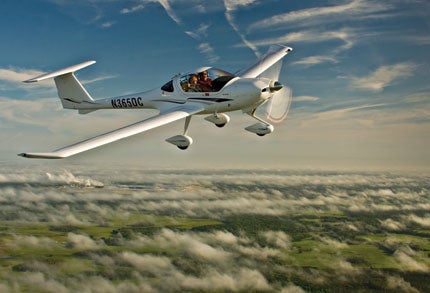 As of two years ago, the training market became a little more complex with the official introduction of a dozen or more light-sport aircraft. Today, the number of different LSA models has swollen to well over 60, and that figure increases on practically a daily basis. Many of these airplanes are fine little two-seaters, easily capable of handling the training mission despite their occasional performance limitations, and that's exactly the market their manufacturers are targeting. No one can tell how many of these LSA manufacturers will survive in the next few years of natural selection, but it seems a safe bet that there'll be a strong LSA presence in flight training.
As of two years ago, the training market became a little more complex with the official introduction of a dozen or more light-sport aircraft. Today, the number of different LSA models has swollen to well over 60, and that figure increases on practically a daily basis. Many of these airplanes are fine little two-seaters, easily capable of handling the training mission despite their occasional performance limitations, and that's exactly the market their manufacturers are targeting. No one can tell how many of these LSA manufacturers will survive in the next few years of natural selection, but it seems a safe bet that there'll be a strong LSA presence in flight training.
Among certified production aircraft, the choices are considerably fewer. There are essentially three semi-dedicated trainer models available; the $88,900 American Champion 7EC Champ, the $179,000 Liberty XL2 and the smallest of the Diamond models, the $174,495 DA20 Eclipse. As you might have noticed, comparing the latter two airplanes to the first is a little like comparing two apples with a grape. The Champ is a traditional, bare-bones, fabric-covered, entry-level taildragger---pure airplane, no ups, no extras; conversely, the XL2 and Eclipse are perhaps the most exotic two-seat trainers you could imagine.
Each model takes a slightly different approach to training, not necessarily better, just different. Traditionalists regard a durable, fabric taildragger as the only way to really learn to fly, while the modern contingent continues to suggest that a composite, nosewheel airplane is more durable, safer and easier to handle in a training environment. (In fairness, Cessna's ubiquitous Skyhawk is another popular trainer.)
We'll leave examination of the Champ and XL2 for another day. We recently spent a day with a new Diamond DA20-C1 Eclipse, and it was an experience somewhere between pure joy and exultation. The littlest Diamond is a true kick in the sky, one of those airplanes that brings the fun back to flying.
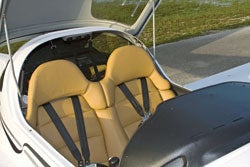 As an extension of the Katana idea, the Eclipse did everything better, and it was definitely targeted to the entry-level pilot and flight school. The airplane was about as simple and straightforward as Diamond could make it, and it has remained as basic as possible.
As an extension of the Katana idea, the Eclipse did everything better, and it was definitely targeted to the entry-level pilot and flight school. The airplane was about as simple and straightforward as Diamond could make it, and it has remained as basic as possible.
The elegant and waspish tail is in T-formation, with an elevator mounted high up out of the prop blast to minimize pitch excursions during power changes. The cabin sports a 45-inch cross section, broad of beam for pilots who share the problem. The aft-hinged hatch folds up and to the rear, allowing pilot and copilot to climb aboard from both sides and providing a strong incentive to make sure it's properly latched. All circuit breakers are in clear view in case something "overvolts." Joysticks spring from the front center of each seat and fall readily to hand. Rudder pedals are adjustable to conform to most body configurations.
The engine is fuel-injected rather than carbureted, so there's no possibility of carb ice and no carb heat control to worry about. The only fuel tank is in an isolated bay in the aft fuselage, so there's no selection to be done. Fuel is either on or off---if the engine runs, you know it's on.
The DA20 is a comfortable airplane, not as snug and compact as a Pitts, but you do have a feeling of wearing the Eclipse rather than simply climbing aboard. Visibility with all that Plexiglas is excellent, though the overhead hatch design makes no provisions for sun visors, and after a while in the hot summer, the canopy takes on a greenhouse effect.
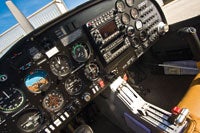 |
| The Eclipse features an aft-hinged hatch that folds up and to the rear, allowing a pilot and copilot to climb aboard from both sides. Joysticks are in the front center of each seat, falling readily to hand, and all of the trainer's circuit breakers are in clear view. |
Despite what might appear to be an almost delicate structure, the DA20 is actually unusually strong and durable. Diamond has certified the airplane to the more rigorous demands of the utility class. That means G-limits are 4.4 rather than the normal category's 3.8.
Similarly, the DA20 is approved for spins, one reason the U.S. Air Force has selected the Eclipse as its trainer for the Air Education Training Command in Colorado Springs, Colo. (The Air Force uses the DA20 for its 40-day, 25-hour Initial Flight Screening of up to 1,700 pilot candidates yearly. The training fleet will total 45 airplanes when deliveries are complete.)
Takeoff with each horsepower lifting 14 pounds of airplane is a fairly leisurely process, but the Eclipse still manages to lift off in 1,300 feet and transition into a surprisingly aggressive climb, a characteristic the USAF found especially attractive in Colorado's frequent high density altitude conditions.
Despite (or perhaps because of) its advantages in primary flight training, the Eclipse has an attraction outside the training arena, and in that respect, climb and cruise numbers score well. Flight schools don't care much about climb and cruise in a trainer, as there's little need to vault a few thousand feet up to altitude only to race 10 miles out to the practice area. Conversely, private owners care a great deal about their airplanes' vertical and horizontal speed, especially in this day of continuously rising fuel prices in which the equation of time, fuel and distance has a significant impact on deflating an owner's wallet.
To that end, the DA20 offers a combination of performance uncommon for an airplane in this class. Climb is listed as 1,000 fpm, and that's certainly not a function of the power or wing loading, neither of which is that impressive. It very well may be related to the airplane's European Wortmann FX 63 airfoil section, a combination of short chord and long span that results in an aspect ratio of 10.2. (Aspect ratio is the proportion between a wing's span and average chord. All other things being equal---which almost never happens---the higher the aspect ratio, the more efficient the wing.)
In contrast, a Bonanza scores 6.2 and a Warrior 7.2. Drawing on their days of building superefficient sailplanes with high lift-to-drag ratios, all Diamond's airplanes feature high aspect ratios. The DA20 offers the best aspect ratio of any trainer.
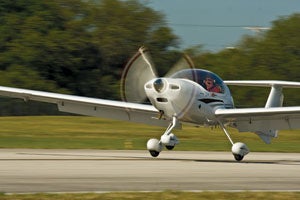 |
| Powered by a 125 hp Continental IO-240 engine, the Eclipse trainer climbs at 1,000 fpm and cruises at well over 130 knots. With the 24-gallon tank full, you can cover almost 400 miles in three hours on just 18 gallons. |
It may also offer the best mileage of any production piston airplane in the sky, at least of any that burn avgas. Like the other Diamonds, the Eclipse is a slippery composite design, with very little left hanging out to grab the wind. There are no rivet heads, butt joints or any other protrusions to pull down the speed, just an incredibly smooth composite wing and fuselage surface to facilitate the passage of air.
The small, 240-cubic-inch Continental engine puts out only 125 hp, and cruise speed is still well over 130 knots. Even at 6 gph, that works out to nearly 22 nm per gallon, or 25 seat miles per gallon in automotive parlance. In other words, with the single, fuselage-mounted, 24-gallon tank full, you could expect to cover nearly 400 miles in three hours on only about 18 gallons. I can't think of another airplane that could come close to that number, much less any car at the same speed. Even if you could talk the California Highway Patrol into closing off Interstate 5 between L.A. and Sacramento, you'd be hard pressed to duplicate that time in a Ferrari, and you'd probably burn at least twice the fuel.
Handling is exemplary. Stalls are pretty much whatever you need them to be---gentle and forgiving, if that's your wish, and aggressive if you're determined to spin the airplane. Pushrods rather than cables provide quick, positive roll response, and pitch control strikes exactly the right median between too quick and too slow. I flew a one-hour air-to-air session in the Eclipse in conjunction with this story, and it was relatively effortless to keep the little airplane tucked in 20 to 30 feet from Jim Lawrence's Canon camera.
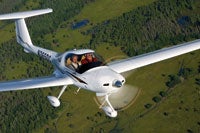 One interesting aspect of the DA20: It's not currently certified for IFR. It's possible to equip the airplane with full IFR instrumentation and avionics, and you can train for the instrument rating under the hood in VFR conditions, but you can't legally fly in the real, live clag. Lightning-strike certification is the hang up. Diamond currently has no plans to certify the Eclipse for lightning strikes, so the airplane is limited to operation in VFR conditions.
One interesting aspect of the DA20: It's not currently certified for IFR. It's possible to equip the airplane with full IFR instrumentation and avionics, and you can train for the instrument rating under the hood in VFR conditions, but you can't legally fly in the real, live clag. Lightning-strike certification is the hang up. Diamond currently has no plans to certify the Eclipse for lightning strikes, so the airplane is limited to operation in VFR conditions.
Another consideration on the Diamond DA20 is that the airplane has an upper temperature limit. The DA20s are pure composite designs, and for that reason, the primary color is white with a few stripes down the middle. Technically, the no-fly temperature that might result in delamination is so high that it's unlikely you'll ever see it. The limit is 55 degrees C (131 degrees F). Even if you let the airplane sit unprotected for a week in Phoenix, Ariz., in August, you'd be unlikely to encounter such a high airframe temperature.
Perhaps above all else, Diamond's DA20-C1 Eclipse is first and foremost a thinking man's airplane. It's a comfortable ride for two, performance numbers are generally excellent for the horsepower, fuel burn is modest and the composite structure suggests minimum maintenance.
On top of all that, the Eclipse is a fun ride that should endear both current and future pilots to the Diamond line and make stepping up to the larger, more powerful Diamonds irresistible.
SPECS: 2008 Diamond DA20-C1 Eclipse

Subscribe to Our Newsletter
Get the latest Plane & Pilot Magazine stories delivered directly to your inbox





